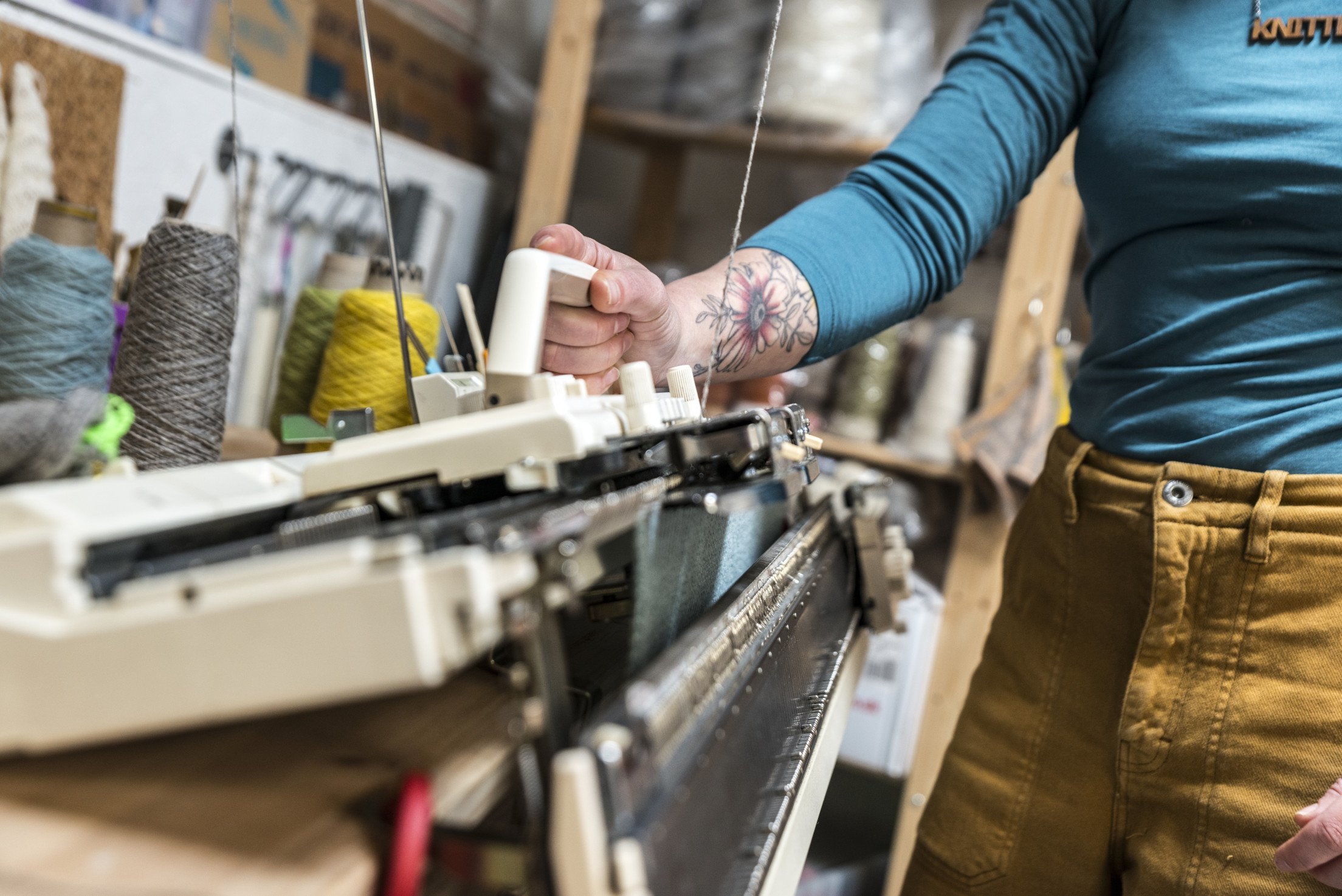Portrait by Joanne Crawford, June 2024
Hi, I’m Ria.
I design and make local wool knitwear, grow and work with natural dye plants, and provide education in natural dyes and British wool via workshops, book and research projects.
I make small batch clothing and accessories from local, traceable wool. I hand dye my garments with homegrown and foraged plants, handmaking each piece to create a locally made, long-lasting, and unique product that works with, not against, the environment.
My knitwear is designed for longevity and made to be cherished, looked after, and passed on. I take pride in showcasing the natural hues and qualities of British wool – a soft, warm, and durable textile.
Everything that Ria Burns Knitwear produces is made by me in Bristol. It’s local, and it’s traceable.
What Ria Burns Knitwear is all about
Ria Burns Knitwear is an antidote to fast fashion.
I’m committed to regenerative agricultural practices that go beyond sustainability. For me, it’s all about local, climate beneficial, slow fashion.
Almost everything in my supply chain can be fully traced (except the mordant I currently use to make sure the colours last). Everything is sourced as close to Bristol as I can get it.
I follow the Fibreshed approach of creating soil-to-soil textiles – meaning my knitwear is made from natural fibres and dyes, and totally biodegradable. At the end of its life as a garment, the wool can be composted, returning nutrients to the soil.
I’m always thinking about how I can have the lowest environmental impact, from sourcing the raw materials and making the knitwear, to zero waste manufacturing processes and plastic-free packaging. Everything counts – my yarn ends get used to attach my swing tags, and the tiny scraps go into the compost which feeds next years' dye plants.
Where my products come from
The Yarn
The yarn I use is a bespoke Shetland-Romney lambswool. It’s from a single flock reared and sheared by Jen and Andy at Fernhill Farm in the Mendips in Somerset - 18 miles down the road from my Bristol home studio. Fernhill wool is certified regenerative, and Jen and Andy were the Farmer’s Weekly sheep farmers of the year in 2022. (I recommend visiting them on their bi-annual open day).
The farm sends the raw fleece (in bulk) to Halifax to be scoured. It then goes to Curlew Weavers mill in Wales, who turns the cleaned wool into a bouncy, woollen-spun yarn which arrives on cones.
The yarn is woollen spun from the lamb’s first ever clip. This means the yarn is soft and bouncy, but also hard-wearing.
I have two colours of yarn - one is a natural, unbleached white with beautiful heathery tones running throughout, the other is a natural grey made from a special blend of white and dark brown fleece. Sometimes, I let the colour of the wool speak for itself, and other garments are given vibrant flashes of colour using the dye plants that I grow.
(Images courtesy of Fernhill Farm)
The Plants
I only use dyes derived from plants. I grow 95% of the plants I use for dyeing in my tiny Bristol back garden, choosing plants that are hardy to the British climate and that don’t need much watering or additional feeding.
I supplement these homegrown plants by foraging in the local area, picking plants that are in season and plentiful. I’ve tested all the dye plants I use for their longevity to light exposure and washing, so you get a comfy, cosy piece of knitwear with colour that lasts.
The Design & Knitting Process
Once the wool has been grown, sheared, sorted, scoured, spun, and dyed, it ends up on my 1980s knitting machine (called Betty!), which is completely hand-powered – no electricity needed.
People often assume that machine knitting is automatic, but it requires quite a lot of highly skilled handwork. I choose to use this manual equipment as I enjoy being hands-on throughout thr entire making process.
My design process is also relatively analogue. I’ve used software in the past, but I prefer designing colourwork patterns using pen, paper, and punch cards.
My debut book - available to buy now!
A bit more about me and my brand
I have a first in BA Fashion Design from Batley School of Art and an MA in Textile Design from Bath Spa University. I researched and developed my brand of naturally dyed, British wool knitwear during my MA and launched the brand in September 2018 via a Crowdfunder campaign. This enabled me to raise the funds to build my dye garden, move into a studio, and invest in my first batch of local wool.
Since then I have built my business and brand to be multi-faceted. Alongside making knitwear and growing the dye plants, I facilitate workshops and provide guest lectures in natural dyes and horticulture. I also provide freelance dyeing and design services and consultancy to brands and artists.
In 2023 I achieved a Level 2 Qualification in Practical Horticulture (RHS), and I became a published author. My book Dyeing Yarn Naturally is available to buy now from my shop or all good booksellers.
I recently published a research project called ‘South West Colour Library’ funded by South West England Fibreshed, of which I am an active member.
If you want to see what I get up to day-to-day, follow me on Instagram.
Other things I do:
provide design and consultancy services to small and emerging sustainable brands/wool producers
undertake research into natural dyes with universities and other organisations
collaborate with artists and artisans wishing to use natural dyes in their work
naturally dye yarn and garments to order for other small businesses
work with local stockists that share my ethos
lecture/teach natural dyeing classes in academic and private settings
sell limited edition, naturally dyed yarns and dye kits
I am always up for sharing ideas and collaborating with other craftspeople and textile innovators – get in touch and let’s talk!






